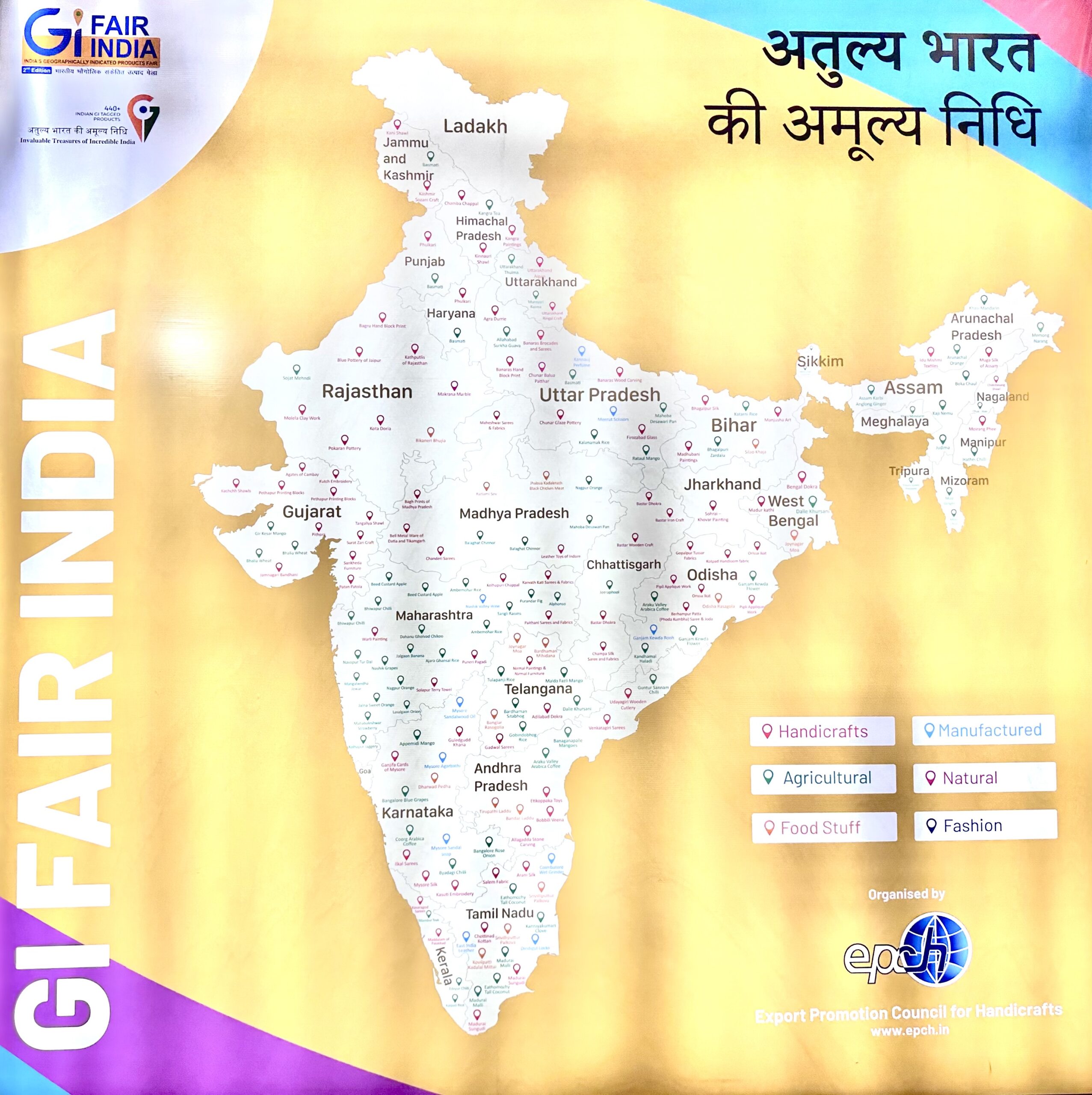Special Report by Paridhi Agarwal
The 2nd edition of GI Fair India, featuring unique and authentic GI-tagged products from across the country was held at India Expo Centre and Mart, Greater Noida from July 20th to 24th this year. This fair showcases products with India’s geographical indications ranging from handicrafts & handlooms, materials & wares, food & ingredients, beauty, nature & wellness, home & collectibles to ethnic wear & accessories. A total of 102 exhibitors displayed products ranging from Kashmiri Saffron to Traditional Mysore paintings. The fair is organized by the Export Promotion Council for Handicrafts (EPCH), an organization of handicraft exporters in India.

Image: GI fair India, 2023 showcasing the rich Indian heritage
What are GI tags?
GI or Geographical Indication is an internationally accepted sign used on products that have a specific geographical origin. It is a form of Intellectual Property Right (IPR) granted to producers in a specific geography. The tag means that the product is produced or created in a particular state or place and has the qualities and name of that originating place.
Intellectual Property Right (IPR): A right given to a creator or inventor to protect their creation.
In India, these tags are given by the Geographical Indication Registry in Chennai. Darjeeling tea was the first Indian product to receive this tag. To date, 460+ products have been given this tag in the country. These include the following categories of products:
- Handicrafts & handlooms : 260+
- Agricultural products: 160+
- Foodstuff: 23
- Manufactured: 12
- Natural products: 3

Image: Map display at the fair site showing Indian states with their unique GI-tagged categories
Some of the products exhibited at the fair are shown here.
Image: Odisha’s Pattachitra
This ancient artwork of Odisha is an intricate brushwork on palm leaves or silk cloth using natural dyes and pigments. They usually depict religious themes. Odisha Pattachitra was awarded GI tag in the year 2008.
Image: Madhubani paintings from Bihar
Madhubani is a folk painting art from the Mithila region of Bihar. These paintings are drawn with symbols like fish, peacocks, serpents, etc. These symbols stand for different themes. For example Fish stands for fertility and good luck; Peacocks indicate love, religion, and romance. The paints used in these paintings are all natural and artists use various objects like brushes, twigs, matchsticks, or their fingers to create these. This famous art was GI tagged in 2005.
Image: Firozabad glass mosaic lamps
Firozabad glass art was granted GI tag in the year 2014. These items are created with mouth-blowing technique and are an example of extremely fine craftsmanship. Some of the most popular glass craft items include bangles, lamps, and decorative items. These items are very popular across the world.

Image: Paithani silk saree from Maharashtra
These sarees trace their origin from Paithan taluka of Aurangabad from where they were exported till as far as the Roman empire. Inspired by the designs from Ajanta paintings, these sarees take months to complete and are made using silk and Zari. Some common motifs used in these sarees are peacocks, parrots, and lotus.
Image: Varanasi wooden lacquerware & toys
These traditional toys represent a centuries-old craft from Varanasi and are created from local woods like mahua, mango, and eucalyptus. These are usually crafted from a single block of wood, covered with lacquer to give them a shine, and then hand-painted using a brush made from the hair of a squirrel’s tail for detailing. This art received a GI tag in the year 2015.
Lacquer: Liquid used to paint wood or metal to form a hard shiny surface

Image: Mysore Rosewood inlay
Rosewood inlay artwork is a 400-year-old traditional artwork patronized by the rulers of Mysore and adorning the walls of Mysore Palace till date. Locally known as Mysuru Kundana Kale, this craft involves inserting pieces of contrasting materials like ivory shells, sandalwood, and colored wood into the depressions made in a rosewood base to create ornaments or pictures. This art form was given GI tag in the year 2005.

Image: Moradabad metal craft
Moradabad, also known as the brass city of India, has been known for these fine handmade and hand-engraved brass items for ages. This art form which also shows traces of Islamic culture was given GI tag in 2014. These art pieces go through a detailed process of molding, casting, etc before reaching their final form.
All Image Credits: Paridhi Agarwal, Noida










